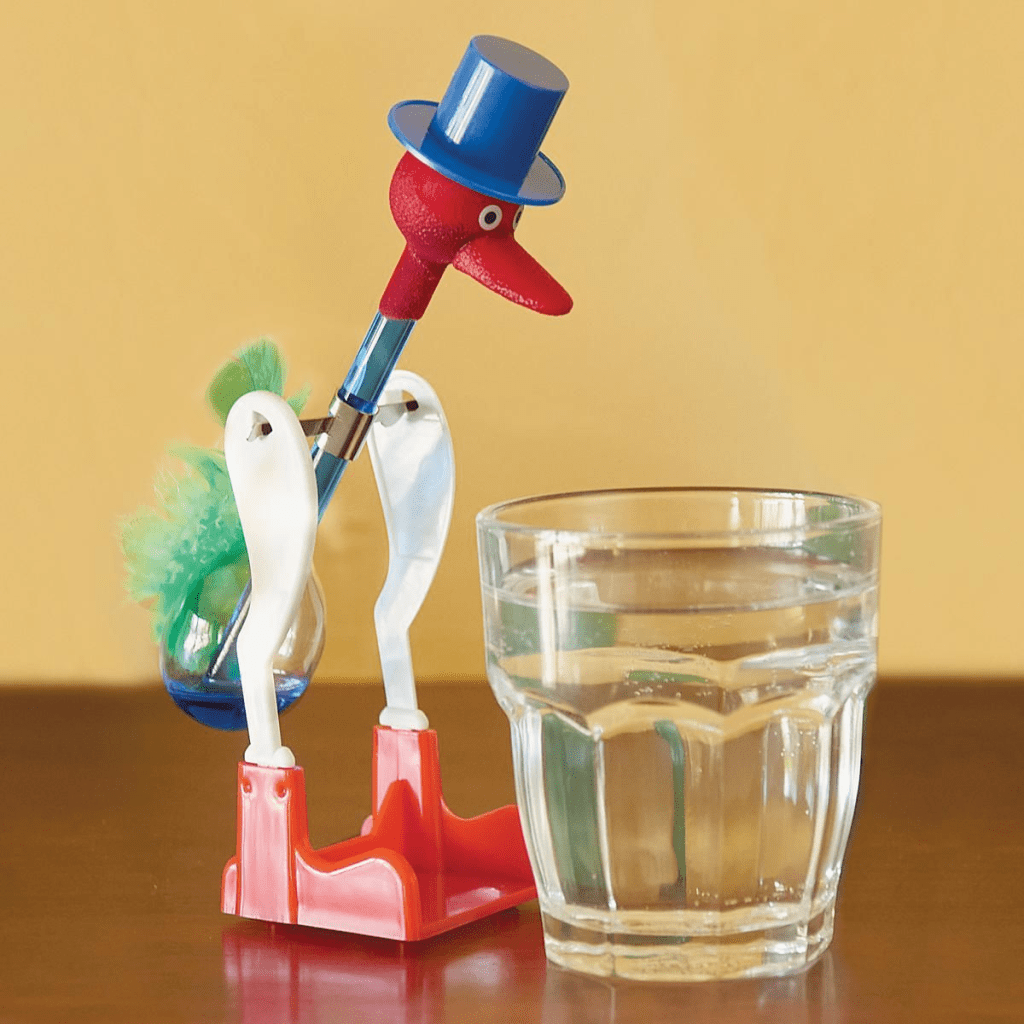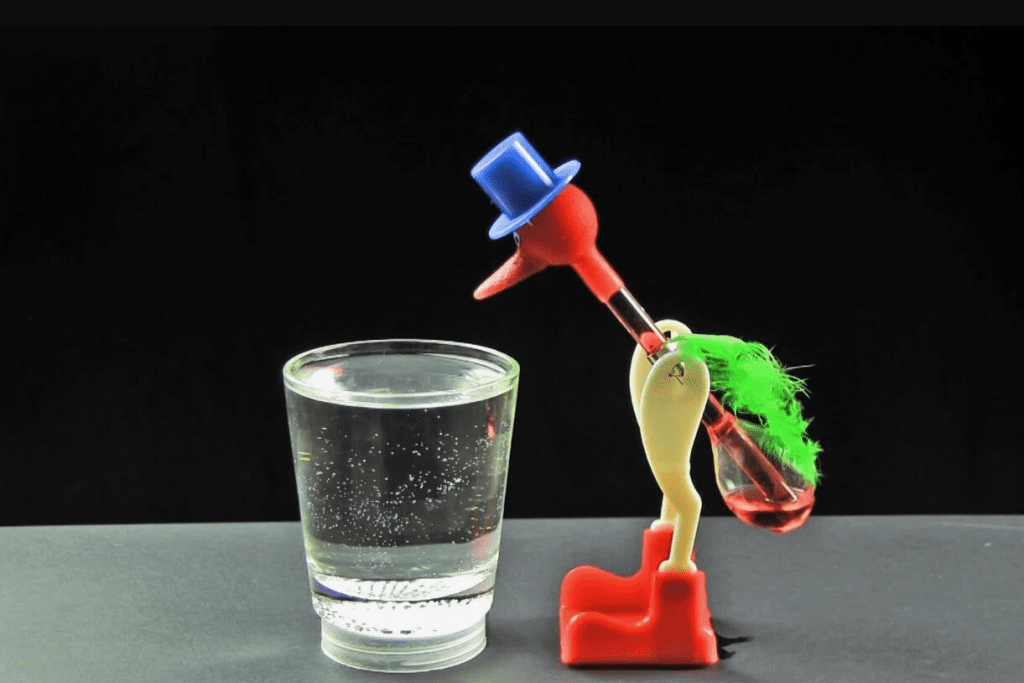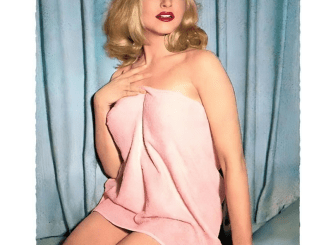The drinking bird, sometimes called the “dippy bird” or “sippy bird,” is more than just a quirky desk ornament; it’s a captivating display of thermodynamics and fluid mechanics in action. Despite its simple, playful design, this toy offers a fascinating look into principles that power real-world heat engines and machines. Let’s explore the drinking bird’s history, how it works, and why it continues to intrigue people of all ages.
A Brief History of the Drinking Bird

The drinking bird’s origins trace back to the early 20th century, although variations of heat engines based on similar principles existed even earlier. The modern drinking bird we know today is often credited to chemist Miles V. Sullivan, who refined the design in the 1940s. Sullivan’s improvements enabled the drinking bird’s mass production, making it a household novelty and an educational tool. Over the decades, this toy has not only found its place on office desks but also made appearances in classrooms and pop culture, illustrating scientific principles in an accessible way.
How the Drinking Bird Works: A Simple Explanation
At first glance, the drinking bird’s repetitive motion might seem magical. However, it operates based on straightforward scientific principles. The bird comprises two glass bulbs—one for the “head” and one for the “body”—connected by a thin tube, creating a closed environment that’s partially filled with a volatile fluid, typically dichloromethane. Here’s a step-by-step breakdown of how the drinking bird works:
- Moistening the Beak: When the bird’s beak is dipped in water, the felt material absorbs moisture.
- Evaporation Cooling: As water evaporates from the beak, it cools the head bulb.
- Pressure Imbalance: This cooling causes the vapor inside the head bulb to condense, creating a drop in pressure.
- Fluid Transfer: The higher vapor pressure in the bottom bulb pushes the liquid up into the head bulb, making the bird top-heavy.
- Dipping Motion: The bird tips forward to dip its beak back into the water, resetting the cycle.
This continuous cycle, driven by temperature differences, gives the illusion of perpetual motion. However, it’s not truly perpetual since it relies on the constant evaporation of water to keep moving.
Understanding the Science: Thermodynamics in Action
The drinking bird operates as a heat engine, illustrating several key scientific concepts:
- Evaporation and Cooling: The cooling effect of evaporating water reduces the pressure in the head bulb, causing the liquid in the bottom bulb to rise. This process is similar to how sweating cools our bodies.
- Ideal Gas Law: The toy demonstrates the relationship between temperature and pressure, as warmer gases in the bottom bulb expand and push the liquid upwards.
- Center of Mass and Torque: As the fluid shifts, the bird’s center of mass changes, causing it to tip over and dip its beak into the water. This balance shift is an example of torque in action.
Is the Drinking Bird a Perpetual Motion Machine?
Despite appearances, the drinking bird isn’t a perpetual motion machine. Perpetual motion would imply that the bird could operate indefinitely without an external energy source, defying the laws of thermodynamics. In reality, the drinking bird relies on a temperature gradient—created by water evaporation—to function. Without water to moisten the beak, the bird would stop moving as the cooling effect ceases.
Materials and Construction: What’s Inside the Drinking Bird?
The drinking bird’s design is both functional and decorative. Its structure typically includes:
- Glass Bulbs: The top bulb (head) and bottom bulb (body) are glass chambers connected by a glass tube.
- Dichloromethane: This fluid is used because of its low boiling point, allowing it to vaporize at room temperature and generate the necessary pressure changes.
- Felt and Decorative Elements: The beak is covered with felt to absorb water. The bird often features paper eyes and sometimes even a top hat or tail feathers, adding to its whimsical appearance.
Popular Culture and Educational Value

The drinking bird has charmed audiences beyond classrooms, making appearances in popular media. For instance, it was featured in the film Airplane! and used humorously in The Simpsons. In educational settings, the drinking bird offers a hands-on demonstration of thermodynamics, ideal for teaching concepts like the combined gas law, pressure-temperature relationships, and fluid dynamics.
The Drinking Bird as an Educational Tool
For students, the drinking bird serves as an engaging way to learn complex physics concepts in a tangible, visual format. Teachers use it to demonstrate principles like:
- Heat Engines and Thermodynamics: The bird is an accessible example of how temperature differences can drive mechanical work.
- Fluid Dynamics: It shows how pressure changes can move liquids within a closed system.
- Energy and Motion: The bird illustrates the concept of energy transfer and how temperature differences translate into motion.
This toy is a practical educational tool, making it easier to grasp scientific principles that may otherwise seem abstract.
Safety Considerations

Although the drinking bird is generally safe, it’s important to handle it with care. The dichloromethane fluid inside is a volatile substance and can be harmful if the bird breaks. Dichloromethane is known to cause skin irritation and may have carcinogenic properties if inhaled or ingested. If the bird breaks, it’s best to ventilate the area, avoid contact with the liquid, and allow it to evaporate safely.
Why the Drinking Bird Continues to Fascinate
The drinking bird has endured as a novelty and educational tool for many reasons. It combines simplicity with scientific depth, making it accessible to a wide audience. For many, watching the bird dip into the water again and again is both relaxing and thought-provoking. It serves as a gentle reminder of the hidden science in everyday objects and the beauty of thermodynamics in action.
Conclusion: The Drinking Bird as a Bridge Between Science and Play
The drinking bird may seem like a mere desk toy, but it’s a brilliant example of science disguised as play. By exploring concepts like pressure, evaporation, and energy transfer, this little contraption bridges the gap between entertainment and education. Whether it’s used in a classroom, as a conversation piece on a desk, or as a nostalgic collectible, the drinking bird continues to delight and educate, ensuring its place as an enduring icon of novelty science.


